Abstract
Dolostone is an important reservoir for hydrocarbons, and significant hydrocarbons have been produced in the Middle Permian Qixia Formation dolostone reservoirs in the southeastern Sichuan Basin. The origin and formation process of the dolomite reservoir in the research area are studied through thin-section, geochemical, and sedimentary cycle analyses and U-Pb geochronology. Three types of dolomites were identified, including stratiform fine-crystalline dolomite (D1), patchy fine-crystalline dolomite (D2), and saddle dolomite cement (SD). D1 and D2 exhibit a range of δ13C values from 3.39‰ to 4.21‰ and a range of δ18O values from −6.06‰ to −5.75‰, indicating a mild depletion of δ18O relative to coeval seawater while maintaining seawater-equivalent δ13C signatures. Their 87Sr/86Sr ratios and REE patterns indicate seawater-derived fluids for D1 and D2 (both test results showed a U-Pb age of ≈274 Ma) and hydrothermal origin for SD. Sedimentary cycle analysis found that the regression process in the fourth-order sequence is conducive to the formation of dolomite under the background of regression in the third-order sequence. Exposure of bioclastic shoals enabled evaporated seawater reflux, forming penecontemporaneous D1 in fluid-saturated settings. Selective dolomitization occurred in the bioturbation structure with good porosity and permeability, forming D2. In the burial stage, the hydrothermal fluid had a slight transformation on the dolomite and formed SD. This model highlights transgressive–regressive cycle controls on reservoir development, providing exploration criteria for analogous carbonate systems.
1. Introduction
Dolomite is a widely distributed carbonate rock in the world, and its formation process is a research hotspot in the field of sedimentology [1,2,3,4,5]. In the Sichuan Basin, the proven oil and gas resources of the Sinian Dengying Formation and Triassic Feixianguan Formation dolomite reservoirs have exceeded a 1 trillion cubic meters, showing the huge exploration potential of marine carbonate rock series [6,7,8,9,10,11,12]. In recent years, exploration breakthroughs of the Permian Qixia Formation in the basin have further highlighted the importance of dolomite reservoirs: the northwest and central Sichuan regions have obtained industrial gas flow with a daily gas production of more than one million cubic meters per well, which confirms the strategic position of this formation as an important replacement field [13,14,15].
Since the dolomite problem was put forward, previous studies have examined the distribution of Phanerozoic dolomite using the mineral composition of calcium carbonate in seawater [7,16], the chemical properties of seawater [17,18], and the level of carbon dioxide partial pressure [19]. It is believed that the conditions of aragonite sea and high carbon dioxide partial pressure are conducive to the formation of dolomite, which is in agreement with the dolomite abundance in geological age. However, the Permian Qixia Formation lacks favorable conditions for extensive dolomite development, as evidenced by the limited scale of dolostone occurrences within the stratigraphic sequence. Consequently, investigating the genesis of these small-scale dolostones contributes to a deeper understanding of dolomitization mechanisms.
According to traditional exploration understanding, the genesis of dolomite in the Qixia Formation is attributed to the control of sedimentary facies. The platform margin beach in Northwest Sichuan and the platform inner beach in Central Sichuan are the main areas of dolomite development [20,21]. The open platform environment in Southeast Sichuan is dominated, and the length of the beach in the platform is usually around 5–10 km, while in the central Sichuan Basin, it can extend to over 50 km. However, the FB1 well in Southeast Sichuan encountered thin-stratal dolomite in the Qixia Formation and obtained industrial gas flow, which shows the complexity of the origin of dolomite in Qixia Formation [22]. According to previous reports, due to the impact of the Permian Emeishan Large Igneous Province (ELIP) event, the dolomitization modes of the Qixia Formation mainly include buried dolomitization, hydrothermal dolomitization, and penecontemporaneous reflux dolomitization [14,15,20,22,23,24,25,26,27,28,29]. In the central part of the Sichuan Basin, the dolomite of the Permian Qixia Formation is stratal, vertically superimposed with limestone, and a large number of saddle dolomite cements were observed in the drilling samples, so previous scholars believed that the distribution of dolomite was mainly controlled by faults [28]. The stratiform dolostones in the southeastern Sichuan Basin exhibit limited thickness, with an individual layer measuring approximately 1 m in thickness. In addition to stratal dolomite, patchy dolomite perpendicular to the layer is also found. The tectonic activity in Southeast Sichuan is stable, and the marine sedimentary assemblage of the Liangshan Formation, Qixia Formation, and Maokou Formation is widely developed. The Dongwu tectonic movement occurred at the end of deposition of the Maokou Formation (~250 ma), and the hydrothermal activity had a certain impact on the sedimentation in the basin; however, the fault development in the study area was not obvious, and it was in the outer circle of the influence range of the ELIP [30], so the origin of dolomite should not be mainly controlled by faults.
In recent years, some scholars have studied the relationship between the sea-level changes under the control of astronomical cycles and dolomite formation, so as to improve the control factors of dolomite formation. This paper also studies the origin of dolomite in Southeast Sichuan during the geological period of low dolomite abundance by using geochemical methods combined with the analysis of sea-level fluctuations under the control of fourth-order cycles, which is very important for the study of reservoir genesis and preservation mechanisms.
Sedimentary facies and paleoseawater properties in SE Sichuan are not conducive to the development of large-scale dolomite, and the developmental pattern of dolomite in NW Sichuan and other regions is not suitable for the study area, so the introduction of new research methods, such as high-frequency cycle analysis and carbonate U-Pb dating, help to analyze the formation model of the dolomite reservoir more deeply.
This study aims to summarize the dolomite types of the Qixia Formation in SE Sichuan Basin, investigate their genetic mechanisms, clarify the development patterns of dolomites during geological periods with low dolomite abundance, and enrich the understanding of dolostone genesis in the Permian Qixia Formation of the Sichuan Basin.
2. Geological Setting
The Sichuan Basin is located at the northwestern margin of the Yangtze Platform within the South China Block [30]. The basement of this region has undergone complex tectonic evolution. During the deposition of the Qixia Formation (ca. 283–273 Ma), paleomagnetic evidence showed that the South China plate drifted from the southern hemisphere to the northern hemisphere and was located near the equator [31], which was a paleoclimatic environment with high surface temperature and low CO2 concentration [19], providing favorable conditions for the development of carbonate platforms.
The Late Carboniferous regression from the Upper Yangtze Platform resulted in a brief sedimentary hiatus. The Liangshan Formation sedimentation initiated an extensive marine transgression, with a basin-wide deposition of uniform-thickness marine carbonates. The Qixia Formation in the study area predominantly comprises open-platform facies deposits [32], with sea-level fluctuations manifesting as gradual transgression followed by rapid regression. The identification of two third-order sequences (SQ1, SQ2) was facilitated by their distinct lithologic and well-log characteristics. The Qixia Formation exhibits an average thickness of approximately 125 m across the basin. SQ1 consists of dark-gray to gray-black argillaceous limestone and micritic bioclastic limestone, commonly containing nodular micritic limestone with siliceous nodules/bands at the base. SQ2 is a light gray and grayish-white micrite-sparry bioclastic limestone, and the dolomite is mostly developed in this section. Large-scale intra-platform shoals developed in central Sichuan, contrasting with the small-scale scattered shoals in southeastern Sichuan (Figure 1a).
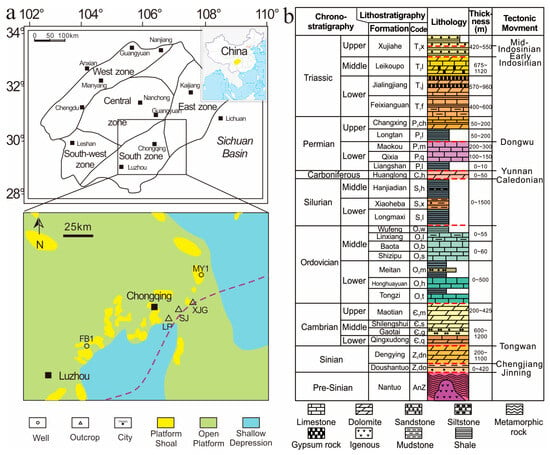
Figure 1.
(a) The location of the research area, distribution of sedimentary facies zones, well locations, and distribution of outcrops in the field. (b) The stratigraphic development and tectonic activity history of the southeastern Sichuan Basin.
The polycyclic tectonic evolution of the basin with multi-phase deformation represents a typical superimposed basin (Figure 1b), where tectonic activities significantly influenced the rock formation and diagenesis in the study area. Pre-Triassic marine cratonic basin conditions prevailed, with the Qixia sedimentation controlled by a “western high-eastern gentle” paleotopography that deepened water conditions in the southeast compared to central Sichuan, explaining the limited shoal development in the southeast [25]. The Maokou Formation maintained the Qixia depositional framework, but the ELIP activity caused the mid-Upper Yangzi to rise above sea level during a later period of the formation, creating karst environments and a middle-upper Permian parallel unconformity. This thermal episode induced extensive basin-wide hydrothermal activity [28,33], which significantly influenced the reservoir formation and modification in the study area.
3. Methods
Experimental samples were collected primarily from drill cores and outcrops of the Qixia Formation in southeastern Sichuan, including core/cuttings from FB1 and MY1 wells, and XJG, SJ, and LP outcrops (Figure 1a). A total of 195 dolostone, limestone, and dolomitic limestone samples were collected. Standard 1-inch cores were drilled for petrophysical analysis. Thin sections were prepared for polarized light microscopy, cathodoluminescence imaging, in situ micro-scale trace element determination, and U-Pb dating. Rock powders (<200 mesh) obtained by handheld microdrill were prepared from the various lithologies for isotopic analysis. Analytical work was carried out at the National Key Laboratory of Deep Oil and Gas (China University of Petroleum, East China) and the Beijing Research Institute of Uranium Geology.
Petrophysical characterizations included helium porosity, permeability measurements, and 1D NMR analysis [34,35,36]. Thin section analysis was performed using Leica DM4P automated polarized microscopy (Lecia, Wetzlar, Germany). Thin sections of 30 μm thickness were prepared from the samples, with calcite stained red using alizarin red S for microscopic examination under plane-polarized light. Cathodoluminescence studies utilized a Nikon LV100POL microscope (Nikon, Tokyo, Japan) coupled to a CITL CL8200 MK5-2 system, operating at a 12 kV/280 mA beam current under a 0.003 mBar vacuum. Thin sections of 80 μm thickness without the staining treatment were utilized for cathodoluminescence observation. Carbonate δ13C/δ18O analysis was performed using a Thermo Fisher 253 Plus IRMS (Thermo Fisher Scientific, Waltham, MA, USA) equipped with GasBench II. The samples (~300 μg) were reacted with 105% H3PO4 at 70 °C for 2 h under He-purged conditions and the CO2 released was measured. Calibration against NBS-18 and IAEA-603 standards achieved analytical accuracies of ±0.06‰ (δ13C) and ±0.08‰ (δ18O) (1σ) [37]. Sr isotope ratios were determined using a Phoenix TIMS (Isotopx, Middlewich, UK) following the methodology of Zhang et al. [38] with uncertainties < 0.000025 (2σ). The rock powder samples used for the Sr isotope measurement were treated with a weak acid (acetic acid) in the pretreatment process. Microscale trace element analysis and U-Pb dating were performed using a LA-ICP-MS (GeoLas HD + Agilent 7900) (Agilent Technologies, Santa Clara, CA, USA). Rock thin sections (80 μm thickness) along with reference standard samples (NIST 614, DC22, and WC-1) were loaded into the instrument. Laser ablation was conducted with a spot diameter of 60 μm, energy density of 8 J/cm2, and repetition rate of 7 Hz. The margin of analytical error, calibrated against standard samples, was maintained below 10%. The content of Ca as the internal standard element during data
processing was deter-mined using EPMA-1720(Shimadzu, Kyoto, Japan). For U-Pb dating experiments, the spot diameter was increased to 160 μm. Each analysis comprised 80 s of signal acquisition, including 20 s background measurement followed by 40 s sample signal collection. Analytical protocols followed Guo et al. [39]. Trace and rare earth element data were normalized to post-Archean Australian shale (PAAS) values.
4. Results
4.1. Petrological Type
In this paper, a total of three types of dolomites were observed in the study area, including stratal dolomite, patchy dolomite, and saddle dolomite cement developed in bioclastic limestone. The classification of dolomite is based on microscopic thin section observation and previous experience in dolomite naming and structure description [40]. D1 type dolomite is a stratal limy fine-crystalline dolomite with a flat crystal plane and self-shaped crystals, with calcite cement in between the crystals. D2 type dolomite is patchy ghost texture fine-crystalline dolomite with a flat crystal plane and subhedral crystal. SD is saddle dolomite cement, which is a coarse-grained saddle crystal with a non-flat crystal plane.
D1 type occurs in FB1 well (Figure 2) and XJG outcrops as a 15–50 cm thick bed and shows weak effervescence with dilute HCl. Partial intercrystalline pores are visible in hand specimens. Upon microscopic examination, the dolomite crystals were observed to exhibit euhedral crystals with flat planes, possessing an average crystal size of 150 μm. The crystals were cemented by calcite (Figure 3b–d), and the dolomite crystals also featured a prominent cloudy-core, bright-rim structure. FB1 well samples contained pore-filling opaque clay infiltrates and bitumen, whereas outcrop samples were predominantly silty infiltrates. A small amount of dolomite with a nonmimetic texture can be seen in the sample, and there is a small amount of traces of dissolution on the edge or inside of some dolomite crystals, and the dissolution area is cemented by calcite (Figure 3b,d). Reservoir space consisted mainly of residual intercrystalline pores.
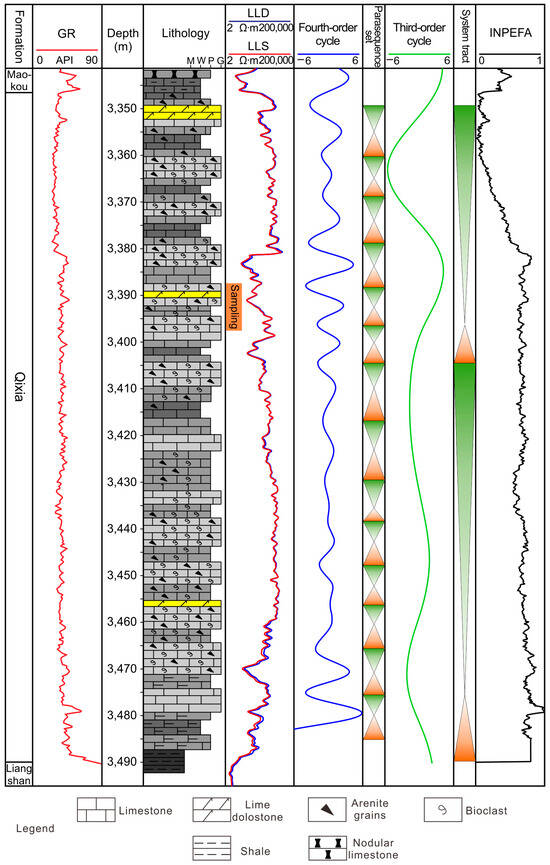
Figure 2.
The comprehensive column chart of the Qixia Formation in the southeastern Sichuan Basin shows the lithology, logging curve, sedimentary cycle division, and INPEFA curve of the FB1 well core. G—Grainstone; P—Packstone; W—Wackestone; M—Mudstone.
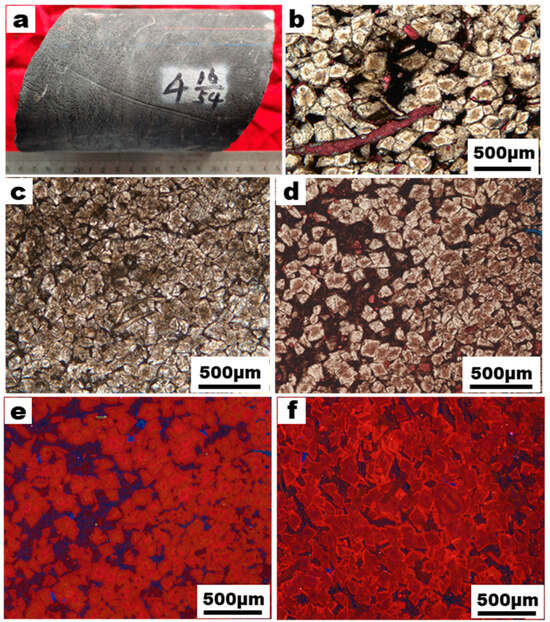
Figure 3.
Core and microscopic thin-section photographs of stratal D1-type dolomite from the Qixia Formation in the study area. (a,b) FB1 4-16/54, at a depth of 3392.55 m. (c) FB1, 3353 m, rock chip. (d) Outcrop sample, labeled as XJG-10. CL images of D1-type dolomite, exhibiting a reddish glow with a brighter ring at the crystal edges, (e) is FB1 4-16/54, at a depth of 3392.55 m, and (f) is XJG-10.
Under cathodoluminescence (Figure 3e,f), D1 dolomite shows red luminescence with distinct zoning patterns. The matrix between the crystals does not emit light, and the bitumen emits blue light.
D2 type dolomite occurs as spheroidal-columnar patches (subvertical to bedding, Figure 4a,b) within bioclastic limestone, predominantly observed in MY1 well. Core observations reveal concentrated dolostone patches forming stratiform zones in the mid-upper part of each sedimentary cycle (Figure 5). The dolomite plunger drilled at the patch shows obvious development of intercrystalline pores (Figure 4c,d). Microscopic observation reveals that the dolomite has a ghost texture in single polarized light (Figure 4e,f), where the ghosts of bioclastic grains can be seen. Selective accounting for the bioclastic grains reveals them in the transition from the dolomitization area to the host rock. Figure 4f shows a section of the sample in Figure 4d where saddle-shaped dolomite cement can be seen intruding into the dolomite patches. In orthogonal light, D2-type dolomite can be seen to have flat-plane and subhedral crystals (Figure 4h). In the field-of-view observation under the microscope, it is found that the part near the cement (Figure 4g) has more translucent crystals, does not develop grain ghost, and is a non-flat crystal plane with anhedral crystals, which is presumed to be the recrystallized D2 type dolomite (D2R). Cast thin sections show pore types including intercrystalline, dissolution vugs, biomolecular pores, and microfractures [41] (Figure 4f).

Figure 4.
Core and microscopic thin section photos of D2 dolomite of the Qixia Formation in the study area. (a,b) is the side and bottom of the same sample, showing the shape of irregular patch on the core, my1 6-28/40, 2970.86 m. (c,d) is the plunger sample drilled in the patch. The upper half (c) is homogenous fine-grained dolomite, and the lower half (d) is dolomite with saddle dolomite cement, my1 6-27/40, 2970.6 m. (e) Dolomite patch, surrounding rock is bioclastic limestone, single polarized, my1 6-28/40, 2970.86 m. (f) Dolomite patch with saddle dolomite cement, single polarized, my1 6-27/40, 2970.6 m. (g,h) The orthogonal light picture and crystal morphology of the two fields of view in f. (i,j) CL photo of type D2 dolomite, showing relatively uniform red light, MY1 6-27/40, 2970.6 m. (k) The bioclastic mold holes are filled with dolomite, which emits red light. MY1 6-15/40, 2968.18 m.
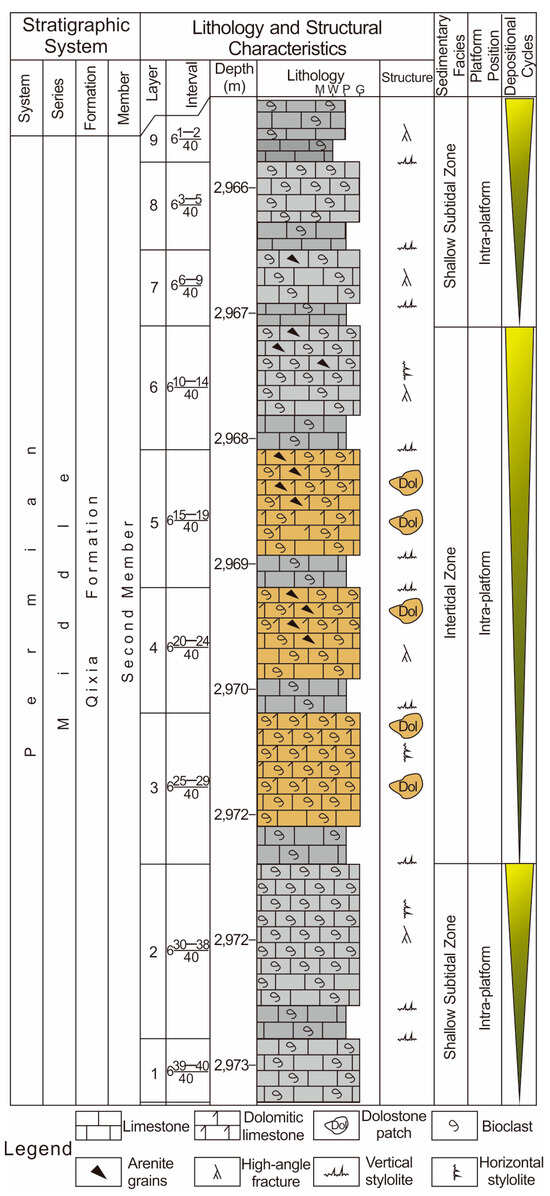
Figure 5.
Detailed observation and description of the core section of the Qixia Formation in the MY1 well in the southeastern Sichuan Basin, showing the lithology of the MY1 well core, vertical development position of dolomite patches, typical core samples, microscopic photos, and sedimentary cycle division. G—Grainstone; P—Packstone; W—Wackestone; M—Mudstone.
Cathodoluminescence of D2 (Figure 4j,k) shows red luminescence with brighter crystal edges and a mosaic texture without zoning.
Saddle dolomite cement (SD) is prevalent in the Qixia Formation and appears as white-yellow patches in cores (Figure 6a,c). Microscopic observations show a clear boundary with the host rock with the following mineral assemblage (Figure 6b,d): marginal coarse saddle dolomite, translucent saddle dolomite, and coarse calcite with residual intergranular porosity.
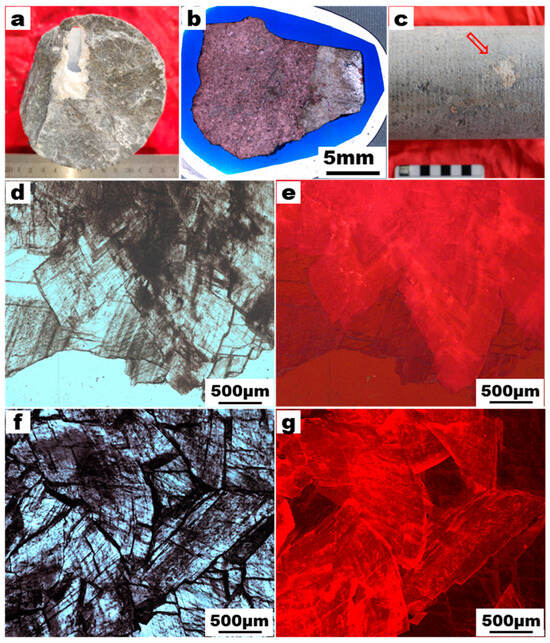
Figure 6.
Core and microscopic thin section photos of SD type dolomite cement of the Qixia Formation in the study area. (a) is the saddle dolomite cement patch on the core, and (b) is the microscopic photo of the sample, FB1 4-50/54, 3398.05 m. (c) Saddle dolomite patch in well my1, MY1 6-30/40, 3398.05 m. (d,e) CL photos. Saddle dolomite has obvious ring bands and emits strong red light. The outside is coarse-grained calcite, which emits dark red light, FB1 4-50/54, 3398.05 m. (f,g) CL photos, saddle dolomite emits uniform red light, and the outside is coarse-grained calcite, which emits dark red light, MY1 6-30/40, 3398.05 m.
4.2. Petrophysical Characteristics
Samples from Well FB1 and Well MY1 were selected for drilling 1-inch plugs, and helium porosity-permeability and one-dimensional nuclear magnetic resonance (NMR) analyses were conducted on them, respectively.
The porosity vs. permeability cross plot for the FB1 well (Figure 7) shows that limestone samples (square symbols) have porosities of 0.48–3.26% (mean 1.33%), while dolomite samples (circular symbols) have improved porosity, which together indicate low porosity/low permeability reservoirs. Figure 7 shows improved porosity in dolomite samples compared to tight limestone counterparts, with the increased permeability of limestone attributed to fracture networks.
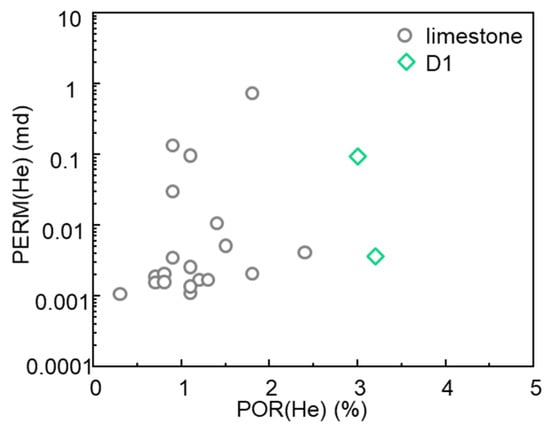
Figure 7.
The porosity and permeability of the FB1 well plunger samples in the research area were measured using a helium gas method. The sample types were simplified to Limestone and D1 type dolomite.
In order to investigate the differences in physical properties between dolomite and limestone during sedimentary cycles, a systematic analysis was conducted on samples from well MY1. Core observations indicated excellent porosity development in MY1 well. As shown in Figure 4, the MY1 well core section was divided into nine subunits according to sedimentary cycles. Samples were collected from the mid-upper grainstone beds of subunits 2-6, with systematic vertical sampling (base-to-top) in subunit 3 for comparative NMR analysis.
Figure 8a shows increasing NMR signal intensity with longer relaxation times in subunits 2-6, reflecting pore space expansion upward through the stratigraphic column [36,42]. Figure 8b illustrates the progressive growth of the integrated signal area from the base to the top within individual subunits, demonstrating vertical porosity enhancement. Dolomitization zones have significantly larger pore spaces compared to non-dolomitization intervals. Relaxation time shifts (short to long) correspond to the pore type transitions from micropores to meso-macropores. Dolostones show strong macropore NMR responses in Figure 8b, in contrast to the mesopore-dominated signature of limestone, which lacks macropore signals.
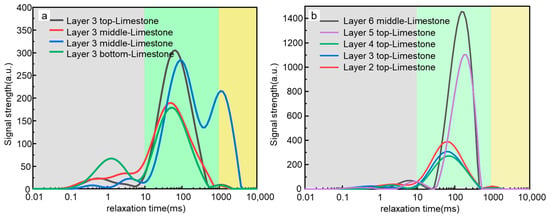
Figure 8.
The T1-NMR spectrum of the MY1 well plunger sample measured after saturation in the research area. (a) Samples taken from bottom to top within the third layer. (b) Samples taken from the upper part of each layer in layers 2–6. The sub layer division is shown in Figure 4.
4.3. C-O-Sr Isotope Characteristics
The samples exhibiting divergent yields were ground into powder for the purpose of testing their δ13C and δ18O (Table 1). The δ13C distribution of the samples from the study area was found to be within the range of 1.65‰~4.73‰ (VPDB), while the δ18O distribution was within the range of −7.57‰~−3.45‰ (VPDB). Utilizing the range of δ13C and δ18O and the evolution of seawater as reported by Veizer et al. [43], the samples with different lithologies were assigned different symbols, and the values were superimposed with the range of seawater during the same period (Figure 9). The data demonstrates that the distribution of δ13C was more concentrated, and that the dolomite and limestone samples were essentially equivalent within the range of seawater during the same period. δ18O was consistent with the seawater value as a whole, but it showed a certain negative bias, and there was no obvious difference between dolomite and limestone. The value of saddle dolomite cement was obviously different from that of the sample.

Table 1.
Isotopic values of the Qixia Formation samples from the study area.
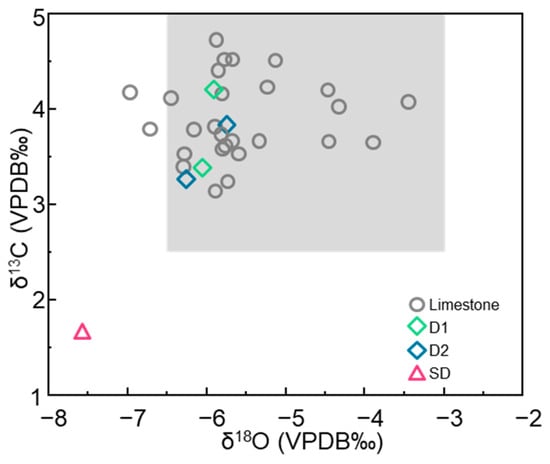
Figure 9.
The distribution range of δ13C and δ18O of the samples in the research area. The shaded part shows the distribution range of seawater isotopes in the same period [43]. D1 and D2 types of dolomite, limestone, and SD are simplified using different symbols.
The oxygen isotope composition of minerals is closely related to the oxygen isotope and temperature of fluids [44]. During diagenesis, as the temperature rises, the dissolution of atmospheric fresh water and the activity of hydrothermal fluid lead to the negative bias of oxygen isotopes. The oxygen isotope value of saddle dolomite is lower than that of limestone and dolomite, and the influence of a high temperature fluid reduces the oxygen isotope value of dolomite and the fractionation difference between saddle dolomite and limestone.
The various samples were transformed into different symbolic representations and plotted with their 87Sr/86Sr values in Figure 10. The distribution range of bioclastic limestone samples from the study area was as follows: 0.7072–0.7075, which is congruent with the range of seawater during the same time period (0.7068–0.7075) [45]. The values of D1 type dolomite obtained in the field and drilling samples were both 0.7073, and the values of D2 type dolomite are also distributed between 0.7073 and 0.7074. The distribution ranges of D1, D2, and dolomitic limestone, along with their respective values, all fell within the same distribution range as the limestone samples. Saddle dolomite cement (SD) had significantly higher values than the other samples and was above the range of contemporaneous seawater.
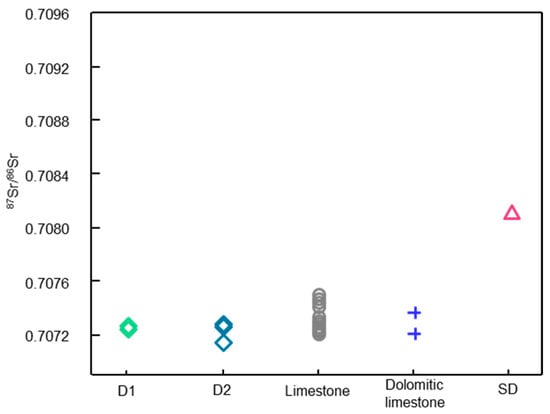
Figure 10.
The distribution range of 87Sr/86Sr samples in the research area. The representation of D1 type dolomite, D2 type dolomite, limestone, dolomitic limestone, and SD were simplified using different symbols.
4.4. Rare Earth Element Characteristics
All trace element data were obtained by LA-ICP-MS tests, and the rare earth element values of the samples were normalized to post-Paleogene Australian shales and plotted in Figure 11. Figure 11a,d show the results of limestone samples, while Figure 11b,c represent D1 results, Figure 11e represents D2 results, and Figure 11f represents SD results. The results of D1 and limestone samples were similar and consistent with the distribution pattern of marine carbonate minerals [46]. In well MY1, the fractionation patterns of limestone were quite similar to those of D2 and SD, but D2 and SD exhibited more pronounced positive Eu anomalies, which were not observed in D1. In addition, there was a significant loss of light rare earth elements in the samples of MY1 well. This loss of light rare earths may be due to the influence of hydrothermal activity during early burial period.

Figure 11.
REE distribution maps of limestone and different types of dolomite in the study area.
4.5. Carbonate U-Pb Geochronology
Carbonate U-Pb dating results were obtained by LA-ICP-MS tests, and the results were corrected by reference standard samples NIST-614, DC22, and WC-1 [39,47,48] and plotted in Figure 12.
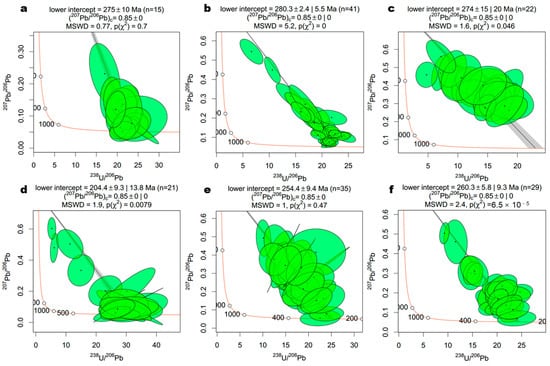
Figure 12.
U-Pb dating results of limestone and different types of dolomite in the study area. (a) Limestone, MY1 6-31/40, 2971.7 m. (b) D1, FB1 4-16, 3392.55 m. (c) D2, MY1 6-27/40, 2970.72 m. (d) SD, MY1 6-27/40, 2970.72 m. (e) D2 recrystallization, MY1 6-27/40, 2970.72 m. (f) SD, FB1 4-50, 3398.05 m.
As illustrated in Figure 12a, the age of the limestone samples was determined to be 275 ± 10 Myr, which is in close agreement with the late deposition time of the Qixia Formation (275–273 Ma). This finding serves as a testament to the reliability of the data processing methods and experimental results employed in this study. Figure 12b presents the age of D1 type dolomite, which is 280.3 ± 2.4 Myr, marking the deposition time of the middle stage of the Qixia Formation. Figure 12c illustrates the age of D2 type dolomite, which is 274 ± 15 Myr, denoting the deposition time of the late stage of the Qixia Formation. Figure 12d displays the result for SD, which is 204.4 ± 9.3 Myr, indicating that it is the cement formed by the hydrothermal fluid brought about by the Early Indosinian tectonic movement. Figure 12e shows the age of D2 dolomite after recrystallization (Figure 13a), and Figure 12f shows the age of coarse-grained saddle dolomite (Figure 6b). The ages demonstrated in Figure 12e,f are around 255–260 Myr, which is consistent with the time of the Dongwu tectonic movement and ELIP at the end of the Maokou Formation [49].
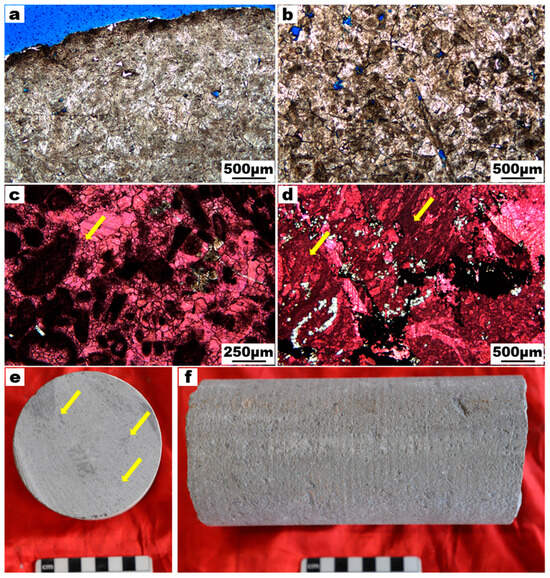
Figure 13.
Thin-section and core photos of MY1 well samples from the Qixia Formation. (a,b) D2 type dolomite, (a) located at the edge of (b), exhibits obvious recrystallization, with curved and transparent crystal planes, and (b) shows ghost texture. MY1 6-27/40, 2970.6 m. (c) Limestone, bioclastic grains are in suspended point contact, and are cemented by bright crystal calcite in the middle. MY1 6-31/40, 2971.7 m. (d) Limestone, karst seepage phenomenon, with bitumen filling inside the suture line. MY1 6-29/40, 2971.3 m. (e,f) Limestone, it can be seen that the edges of the debris particles are filled with bitumen on the core. MY1 6-19/40, 2969 m, and MY1 6-16/40, 2968.3 m.
5. Discussion
5.1. Dolomite Genesis
5.1.1. Origin of D1
This type of dolomite is one of the most significant dolomites in southeastern Sichuan, having been identified in the outcrops and drillings. It has been utilized as a reservoir for oil and gas production, yet the genesis of this particular dolomite is less well documented.
Diagenesis will affect the content and isotope value of elements in minerals. The change in Mn/Sr ratio in carbonate rocks is the key index to identify the degree of diagenetic alteration [50,51]. When Mn/Sr < 0.2, it represents a weak diagenetic alteration, and the original strontium isotope is well preserved. The micro trace element analysis of the samples from the study area shows that D1 and D2 dolomites were not significantly altered by diagenesis and alteration (Figure 14).
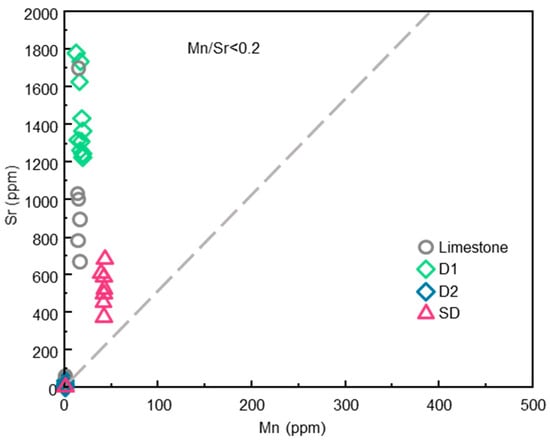
Figure 14.
Cross plot of Mn and Sr values. The area above the gray dashed line represents the range of Mn/Sr < 0.2.
D1 type dolomite has a good degree of self-shape and a relatively dense arrangement between crystals and is generally characterized by haze-centered bright rims and a clear ring band structure under cathodoluminescence, with the core of the dolomite being dirtier and darker, and the rims being translucent and stronger, presumably due to differences in growth rates during crystal growth [2,52]. During dolomitization, rapid crystallization inhibits trace element incorporation, resulting in darker luminescence in crystal cores. In contrast, slow growth at the crystal margins during diagenesis facilitates trace element trapping, thereby enhancing luminescence intensity. This kind of luminescence suggests that the primary dolomitization process occurred at an early stage and was a rapid dolomitization process [53].
As demonstrated in Figure 9, the δ13C and δ18O values of the limestone and dolomite samples from the study area were largely consistent with the distribution range of seawater during the same period. However, the negative δ18O bias in the data from northwest Sichuan is more pronounced, as the area is more severely affected by hydrothermal fluids [53]. This suggests that the dolomite did not undergo significant diagenetic modification during diagenesis [54]. The 87Sr/86Sr values of dolomites are lower than the distribution range of the limestone (Figure 10), which is consistent with that of contemporaneous seawater (0.7068–0.7075) [45]. Furthermore, its REE partitioning pattern is similar to that of the limestone, which is consistent with that of the minerals of marine carbonates. Theoretically, there are systematic differences in the oxygen isotopes between dolomite and limestone from the same fluid source, which mainly manifests in the δ18O value of dolomite being 3‰ higher than that of limestone, but this feature was not reflected in the results. However, the samples from the study area underwent the Early Indosinian and Dongwu tectonic movements during their burial history. The hydrothermal fluids associated with these two tectonic events exerted influence on the rocks, resulting in the depletion of δ18O values in the dolomites and causing them to converge isotopically toward limestones. Combined with 87Sr/86Sr values and the REE distribution model, the data shows that the source of dolomitization fluid was seawater from the same period, rather than hydrothermal fluid [55].
Type D1 dolomite was developed in the middle of the Qixia Formation (Figure 2), and the age of type D1 dolomite was determined to be 280.3 ± 2.4 Myr by U-Pb dating (Figure 12b). Figure 12a shows the age of bioclastic limestone in the top of the Qixia Formation, which is 275 ± 10 Myr. Both ages are consistent with the depositional time of the Qixia Formation. The cathodoluminescence observations reveal that the dolomite cores exhibited darker luminescence compared to the rims. This characteristic suggests a suboxic depositional environment. Rapid dolomitization facilitated the precipitation of Fe3+, which suppressed luminescence. Consequently, the dolomitization is inferred to have occurred during the penecontemporaneous stage.
During the late depositional period of the Qixia Formation, large-scale intra-platform shoals were developed in central Sichuan, resulting in substantial dolomite development. Conversely, small-scale and scattered intra-platform shoals were developed in southeastern Sichuan, leading to a comparatively minor dolomite development in the study area. Lucia et al. [41] have highlighted the dolomitization pattern of seawater reflux, asserting that the packing density of dolomite crystals diminishes in relation to the increase in the distance of the reflux of fluids into the internal beach body. The carbonate platform in the study area was limited in scale and could not have supplied significant volumes of evaporated seawater. As such, the stratal D1-type dolomite was formed by infiltration of small-scale, low-salinity seawater reflux during the penecontemporaneous period (Figure 15a–c) [56].
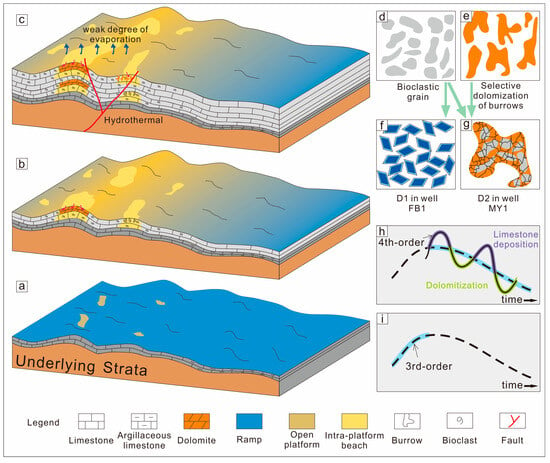
Figure 15.
The seawater reflux dolomitization model in the southeastern Sichuan Basin. (a–c) refers to the development of strata during sea level change. (d–g) is the schematic diagram of two types of dolomite crystal growth during dolomitization. (h,i) is the time of dolomitization under the superposition of different levels of sequences (the upward trend of the curve is transgression, and the downward trend is regression).
5.1.2. Origin of D2
Dolomite crystals of type D2 exhibited a comparable size range to those of type D1. However, their morphological characteristics differ significantly: D1 crystals display superior crystal morphology, whereas D2 crystals are predominantly subhedral with planar crystal faces. Notably, D2 dolomite retains abundant intercrystallite porosity as well. In the region affected by hydrothermal cementation (Figure 4d,f), the D2 crystals are transformed into nonplanar face xenomorphic crystals. Petrographic evidence indicates that D2 dolomite developed within grain-dominated shoals experiencing relatively strong hydrodynamic conditions. The host rock surrounding the dolomite patches in the MY1 well was bioclastic limestone (Figure 4a,e).
According to the geochemical results, the 87Sr/86Sr value of D2 dolomite was consistent with the distribution of limestone in the Qixia Formation, indicating a contemporaneous seawater origin for the dolomitizing fluids. In the REE distribution pattern (Figure 11d–f), the D2 type sample showed LREE depletion with slight positive Eu anomalies, which was different from the D1 type dolomite and limestone in FB1 well. However, the distribution range of δ13C and δ18O of D2 dolomite was consistent with that of the seawater in the same period (Figure 9), and its Mn/Sr < 0.2 (Figure 14) indicates that the diagenetic process was mainly influenced slightly by hydrothermal activities. The sample affected by hydrothermal cement (Figure 4d) was made into thin sections (Figure 4f) and observed under the microscope. It was found that the central area was ghost texture fine-crystalline dolomite with flat crystal plane and subhedral crystal, and the crystal in the area close to the cement transformed into non-flat crystal plane allomorphic crystal, and the hydrothermal activity led to the recrystallization of dolomite crystal. The U-Pb dating method was used to analyze D2 dolomite and recrystallized D2 dolomite (D2-R). The results showed that the formation time of D2 was 274 ± 15 Ma, and the formation time of D2-R was 254.4 ± 9.4 Ma (Figure 12c,e). The sampling location of the sample is near the top of the Qixia Formation. This age indicates that D2 was formed in the penecontemporaneous period, and the formation time of D2-R is consistent with the Dongwu movement, indicating that D2 type dolomite was formed by the dolomitization of seawater reflux in the penecontemporaneous period, and was affected by a hydrothermal solution in some areas, resulting in recrystallization.
The crystal morphology of D2 type dolomite is different from that of D1 type dolomite. The automorphism of dolomite is often affected by many factors, such as crystallization rate, fluid properties, growth space, diagenetic transformation, and so on [57,58]. The U-Pb age indicated that D2 was formed in the penecontemporaneous period. The study area’s platform beach exhibited limited scale, capable only of generating small-scale evaporated seawater. Under conditions of insufficient fluid supply, these fluids preferentially migrate through more permeable zones, resulting in selective dolomitization. The constrained growth space led to the formation of D2-type dolomite with ghost texture.
However, D2 dolomite is porphyritic in macro space, and the reason why it does not form stratal distribution like D1 dolomite needs further discussion. In core observation, it is found that dolomite patches are often developed in the middle and upper parts of a single sublayer sedimentary cycle. Patches are vertical to the layer and are mostly irregular long strips, which can be observed in multiple sedimentary cycles. This feature developed in the middle and upper part of each cycle is also approximately stratal, and its spatial distribution has the characteristics of a bioturbation structure (Figure 15c,e) [59,60]. At the junction of the dolomite patch and surrounding rock, there is a transition state from the dolomite to limestone, indicating that the dolomitization fluid has undergone selective replacement of dolomitization in the biodrillings. Compared with the relatively dense surrounding rock, this irregular bioturbation structure makes the sediment with larger particles in the upper part fill into the borehole, leaving more pores between the particles in the borehole, forming a well-connected primary pore system. Under the action of capillary force in the borehole, the continuous suction and retention of fluid rich in magnesium ions are promoted, and the fluid-rock reaction time is prolonged. The bioclastic materials in the biodrilling are mainly aragonites or high magnesium calcites, which are more easily metasomatized by magnesium rich fluid, which is conducive to the occurrence of dolomitization (Figure 15g) [61]. Therefore, under the coupling of high permeability channel and mineral chemical property difference, this biodrilling was selectively metasomatized by dolomitized fluid, forming patchy dolomite [24,62].
5.1.3. Origin of SD
Dolomite cement (SD) is irregularly patchy (Figure 6a,c) macroscopically. Under the microscope, it is mainly coarse-grained saddle shaped crystals with non-flat crystal planes. The crystal is transparent, and there is an obvious wavy extinction under orthogonal light. Saddle dolomite has many origins [63], but due to tectonic activities, saddle dolomite of hydrothermal origin is widely developed in the whole Sichuan Basin. Its 87Sr/86Sr value is significantly higher than that of the limestone and dolomite samples, and the REE has obvious positive Eu anomalies, which clearly indicates its hydrothermal origin [64]. The U-Pb dating results show that the SD age in well FB1 is 260.3 ± 5.8 Ma (Figure 12f), and the age of recrystallized D2 dolomite (D2-R) affected by the hydrothermal solution in well MY1 is 254.4 ± 9.4 Myr (Figure 12e), which is consistent with the time of occurrence of the Dongwu tectonic movement. In addition, in well MY1, the age of saddle dolomite cement is 204.4 ± 9.3 ma, which is the time when the Early Indosinian tectonic movement occurred. By observing the cathodoluminescence images of two kinds of saddle dolomite cements, it was found that the SD in FB1 well has obvious annular structure, while the SD in MY1 well has more uniform luminescence, indicating that the formation of saddle dolomite cements in the study area was affected by two stages of hydrothermal activities.
5.2. Reservoir Characteristics and Controlling Factors
Within the study area, the predominant reservoir type is porosity-dominated dolomite. Section 5.1 of this paper discusses the potential origins of these dolomites, revealing that both D1 and D2 type dolomites with moderate reservoir quality are inferred to have formed during the penecontemporaneous stage. Core observations indicate that both dolomite types developed within grain-dominated bioclastic shoals, classified as intra-platform shoal facies. Integrating previous studies on the Qixia Formation dolomites in the Sichuan Basin, large-scale dolomite reservoirs primarily occur in intra-platform shoals in the central Sichuan Basin and platform-margin shoals in the western Sichuan Basin [13,14]. This demonstrates that the dolomite reservoir development in the study area is primarily controlled by depositional settings.
In Section 4.2, NMR analysis was conducted on bioclastic limestone samples collected near the top of each subunit within a sedimentary cycle. The results reveal that against a background of marine regression, reservoir quality progressively improves upward throughout the cycle. This trend manifests through NMR spectra variations, confirming that initial reservoir properties are fundamentally controlled by depositional environments. Within cycles containing dolomite development, dolomitization predominantly occurs in the middle-upper segments of the cycles. To investigate the linkage between sea-level fluctuations and dolomitization patterns, this study employed wavelet transform analysis of the GR curve from Well FB1 [65] and INPEFA curve analysis [66]. These approaches correlate macroscopic dolomite reservoir distribution with sedimentary cyclicity at the wellbore scale. Utilizing wavelet transform analysis, the entire FB1 well can be segmented into 14 quasi-sequence groups, and the logging curves can be amalgamated to delineate the corresponding four levels of cyclothems and three levels of sequences. It can be observed that the three levels of sequences obtained by wavelet transform are in alignment with the process of sea level change through the INPEFA curves (Figure 2). In the continuous regressive environment indicated by the INPEFA curve, it is the main period for the development of the Qixia Formation platform shoal, and many stages of dolomite are developed at the top of the parasequence set, indicating that the platform shoal deposition with good initial sediment properties is conducive to dolomitization (Figure 15h,i) [67]. After the sea level fell, a series of small enclosed environments were formed at the top of the shoal in the platform, in which the evaporated seawater infiltrated into the shoal as potentially dolomitizing fluid (Figure 15c). The dolomitizing fluid in the environment of well MY1 was small in scale and low in salinity. During the fluid reflux process, the bioclastic materials in the bioturbation structure were preferentially and selectively replaced by dolomitized fluid (Figure 15g). The MY1 well was not drilled through the entire Qixia Formation, and the coring section was located near the top of the Qixia Formation (10 m below the Maokou Formation), suggesting that the patchy dolomite was developed in the same quasi-stratigraphic group as that at the top of FB1 well (Figure 3). Furthermore, upon microscopic observation of the bioclastic limestone samples from the study area, it was determined that the limestone grains at the upper part of the cycle are in a state of suspension-point contact with one another. As shown in Figure 13c, these particles are cemented by bright calcites. This suggests that during the process of the sea level lowering, the sediments were rapidly cemented, resulting in a significant decrease in the original porosity. This may also have prevented dolomitization fluids from entering efficiently. The intra-platform shoal development in the study area was found to be limited in scale. This would lead to the unfavorable formation of saline seawater and the heterogeneity of the distribution of bioturbated structures [68]. These factors contributed to the observed small-scale development of dolomite reservoirs in the study area, resulting in significant variations in production characteristics.
Dolomite has a strong ability to preserve porosity, and dolomitization is a key process in reservoir formation. However, the adjustment modification brought about by the increase in burial depth during diagenesis (Figure 15) is also an important factor affecting reservoir preservation. In the samples of bioclastic limestone, the grains were cemented by calcite without significant compaction, suggesting that the strong cementation during the penecontemporaneous period resulted in substantial destruction of the initial porosity. Dolomite exhibits superior resistance to compaction and pressure dissolution, while early dolomitization facilitates the preservation of primary porosity [69]. The Dongwu tectonic movement at the end of the Maokou Formation caused a crustal uplift, resulting in large-scale karstification of the Maokou Formation, and the Qixia Formation was similarly affected. Karst seepage was observed in wells FB1 and MY1, where the dolomite crystals were found to be filled with calcareous seepage clays (Figure 3c). Karst seepage zones were also seen in well MY1 (Figure 13d), and it was determined that this had an impact on the preservation of the reservoir [67]. The porosity of the reservoir was reduced by seepage clays between dolomite crystals; however, karst action in the cemented, dense limestone enhanced the seepage capacity of the reservoir. Organic matter, such as bitumen, has been found to fill the seepage zones. The Dongwu tectonic movement and the Early Indosinian tectonic movement produced numerous high-angle fractures in the study area, the majority of which were cemented by calcite. Furthermore, the cement formed by hydrothermal fluids also reduced the pore space, thus resulting in damage to the reservoir [70]. Furthermore, bitumen, as a consequence of the oil and gas injection process, has been observed to fill the pores [71,72]. This phenomenon can be observed in the MY1 well (Figure 13e), where the cast holes at the edges of the clastic grains were found to be filled with bitumen. Moreover, recrystallisation, compaction, and pressure solubilization all caused some damage to the pore space of the reservoir.
6. Conclusions
In this paper, three types of dolomites identified from the Permian Qixia Formation in SE Sichuan were studied by thin section, geochemical, and sedimentary cycle analyses and U-Pb geochronology. The stratiform dolomite (D1) and patchy dolomite (D2) exhibited a range of δ13C values from 3.39‰ to 4.21‰ and a range of δ18O values from −6.06‰ to −5.75‰, and their 87Sr/86Sr values were distributed between 0.7073 and 0.7074. The C-O-Sr isotope results indicate that the dolomitization fluid of D1 and D2 dolomite came from evaporated seawater, and their REE fractionation patterns are similar to those of bioclastic limestones. The results of U-Pb dating indicate that D1 (280.3 ± 2.4 Myr) and D2 (274 ± 15 Myr) dolomites were formed during the penecontemporaneous period. The saddle dolomite cement samples exhibited hydrothermal characteristics, and their ages (204.4 ± 9.3 Myr and 260.3 ± 5.8 Myr) also indicated that they were formed by hydrothermal fluids during tectonic activities.
The stratiform dolomite and patchy dolomite in the study area are considered to be favorable reservoirs for oil and gas. Helium porosity-permeability analysis and 1D-NMR experiments reveal that the dolomites exhibit greater reservoir space compared to limestones. The development of dolomite reservoirs is correlated with variations in sedimentary cycles. During the deposition of the Qixia Formation, the development of bioclastic shoals provided a material basis for the formation of reservoirs. During the third-order sequence regression, the decline in the fourth-order sea level sequence facilitated the occurrence of reflux dolomitization, which helped preserve the original porosity in the reservoirs. With changes in the fourth-order sequence, when evaporated seawater met the criteria for dolomitization, dolomite formed in the upper part of the cycle, ultimately resulting in the development of multiple thin dolomite layers in the vertical section. In addition, the tectonic fracture-hydrothermal activity and oil and gas filling during the early diagenetic stage of the diagenetic process modified the reservoir space.
Author Contributions
Conceptualization, R.X. and G.W.; methodology, L.Q. and L.Z.; investigation, R.X., M.D., and D.P.; writing—original draft preparation, R.X.; writing—review and editing, R.X., G.W., F.H., and L.K. All authors have read and agreed to the published version of the manuscript.
Funding
This study was supported by the Special Funds for Taishan Scholars Program (tsqn202211073), the mechanism of formation and preservation of ultra-deep carbonate reservoirs (P24246) supported by Sinopec Group.
Data Availability Statement
Data are contained within the article.
Acknowledgments
We are grateful to the Sinopec Exploration Company, who provided support for the sample collection, and the National Key Laboratory of Deep Oil and Gas, who provided the laboratories for the analyses.
Conflicts of Interest
The authors declare no conflicts of interest.
References
- Jones, B. Microarchitecture of dolomite crystals as revealed by subtle variations in solubility: Implications for dolomitization. Sediment. Geol. 2013, 288, 66–80. [Google Scholar] [CrossRef]
- Warren, J. Dolomite occurrence, evolution and economically important associations. Earth Sci. Rev. 2000, 52, 1–81. [Google Scholar] [CrossRef]
- Gregg, J.M.; Bish, D.L.; Kaczmarek, S.E.; Machel, H.G.; Hollis, C. Mineralogy, nucleation and growth of dolomite in the laboratory and sedimentary environment: A review. Sedimentology 2015, 62, 1749–1769. [Google Scholar] [CrossRef]
- Mckenzie, J.A.; Vasconcelos, C. Dolomite Mountains and the origin of the dolomite rock of which they mainly consist: Historical developments and new perspectives. Sedimentology 2009, 56, 205–219. [Google Scholar] [CrossRef]
- Machel, H.G. Concepts and Models of Dolomitization: A Critical Reappraisal; The Geological Society of London: London, UK, 2004; Volume 235, pp. 7–63. [Google Scholar]
- Chen, H.; Wang, S.; Mansour, A.; Qin, Q.; Ahmed, M.S.; Cen, Y.; Liang, F.; He, Y.; Fan, Y.; Gentzis, T. Key Characteristics and Controlling Factors of the Gas Reservoir in the Fourth Member of the Ediacaran Dengying Formation in the Penglai Gas Field, Sichuan Basin. Minerals 2025, 15, 98. [Google Scholar] [CrossRef]
- Stanley, S.M.; Hardie, L.A. Secular oscillations in the carbonate mineralogy of reef-building and sediment-producing organisms driven by tectonically forced shifts in seawater chemistry. Palaeogeogr. Palaeoclimatol. Palaeoecol. 1998, 144, 3–19. [Google Scholar] [CrossRef]
- Wang, G.; Li, P.; Hao, F.; Zou, H.; Yu, X. Origin of dolomite in the third member of Feixianguan Formation (Lower Triassic) in the Jiannan area, Sichuan Basin, China. Mar. Pet. Geol. 2015, 63, 127–141. [Google Scholar] [CrossRef]
- Hao, F.; Guo, T.; Zhu, Y.; Cai, X.; Zou, H.; Li, P. Evidence for multiple stages of oil cracking and thermochemical sulfate reduction in the Puguang gas field, Sichuan Basin, China. Am. Assoc. Pet. Geol. Bull. 2008, 92, 611–637. [Google Scholar] [CrossRef]
- Ma, Y.; Guo, X.; Guo, T.; Huang, R.; Cai, X.; Li, G. The Puguang gas field: New giant discovery in the mature Sichuan Basin, southwest China. Am. Assoc. Pet. Geol. Bull. 2007, 91, 627–643. [Google Scholar] [CrossRef]
- Wang, G.; Li, P.; Hao, F.; Zou, H.; Yu, X. Dolomitization process and its implications for porosity development in dolostones: A case study from the Lower Triassic Feixianguan Formation, Jiannan area, Eastern Sichuan Basin, China. J. Pet. Sci. Eng. 2015, 131, 184–199. [Google Scholar] [CrossRef]
- Zhou, L.; Wang, G.; Zhang, Y.; Qiao, Y.; Hao, F.; Xu, R.; Quan, L.; Wang, P. Characteristics and origin of Lower Triassic Feixianguan Formation dolostones on the west side of Kaijiang–Liangping Trough, northeastern Sichuan Basin, China. Mar. Pet. Geol. 2023, 147, 105956. [Google Scholar] [CrossRef]
- Xiao, D.; Cao, J.; Luo, B.; Tan, X.; Liu, H.; Zhang, B.; Yang, X.; Li, Y. On the dolomite reservoirs formed by dissolution: Differential eogenetic versus hydrothermal in the lower Permian Sichuan Basin, southwestern China. Am. Assoc. Pet. Geol. Bull. 2020, 104, 1405–1438. [Google Scholar] [CrossRef]
- Li, P.; Zou, H.; Hao, F.; Yu, X.; Wang, G.; Eiler, J.M. Using clumped isotopes to determine the origin of the Middle Permian Qixia Formation dolostone, NW Sichuan Basin, China. Mar. Pet. Geol. 2020, 122, 104660. [Google Scholar] [CrossRef]
- Quan, L.; Wang, G.; Zhang, Y.; Hao, F.; Xu, R.; Zhou, L.; Liu, Z. Early dolomitization and subsequent hydrothermal modification of the middle Permian Qixia Formation carbonate in the northwest Sichuan Basin. Geoenergy Sci. Eng. 2023, 221, 211384. [Google Scholar] [CrossRef]
- Sandberg, P.A. An oscillating trend in Phanerozoic non-skeletal carbonate mineralogy. Nature 1983, 305, 19–22. [Google Scholar] [CrossRef]
- Rieder, M.; Wegner, W.; Horschinegg, M.; Klackl, S.; Preto, N.; Breda, A.; Gier, S.; Klötzli, U.; Bernasconi, S.M.; Arp, G.; et al. Precipitation of dolomite from seawater on a Carnian coastal plain (Dolomites, northern Italy): Evidence from carbonate petrography and Sr isotopes. Solid Earth 2019, 10, 1243–1267. [Google Scholar] [CrossRef]
- Lowenstein, T.K.; Timofeeff, M.N.; Brennan, S.T.; Hardie, L.A.; Demicco, R.V. Oscillations in Phanerozoic Seawater Chemistry: Evidence from Fluid Inclusions. Science 2001, 294, 1086–1088. [Google Scholar] [CrossRef]
- Mills, B.J.W.; Krause, A.J.; Scotese, C.R.; Hill, D.J.; Shields, G.A.; Lenton, T.M. Modelling the long-term carbon cycle, atmospheric CO2, and Earth surface temperature from late Neoproterozoic to present day. Gondwana Res. 2019, 67, 172–186. [Google Scholar] [CrossRef]
- He, J.; Lian, Z.; Luo, W.; Zhou, H.; Xu, H.; He, P.; Yang, Y.; Lan, X. Characteristics and main controlling factors of intra-platform shoal thin-layer dolomite reservoirs: A case study of Middle Permian Qixia Formation in Gaoshiti–Moxi area of Sichuan Basin, SW China. Pet. Explor. Dev. 2024, 51, 69–80. [Google Scholar] [CrossRef]
- Yang, G.; Wang, H.; Shen, H.; Yang, Y.; Jia, S.; Chen, W.; Zhu, H.; Li, Y. Characteristics and exploration prospects of Middle Permian reservoirs in the Sichuan Basin. Nat. Gas Ind. B 2015, 2, 399–405. [Google Scholar] [CrossRef]
- Bai, X.; Wen, L.; Zhang, Y.; Zhang, X.; Wang, J.; Chen, Y.; Peng, S.; Wang, W.; Zhong, J.; Li, Y.; et al. Origin of facies-controlled dolomite and exploration significance of the Middle Permian Qixia Formation in central Sichuan Basin, Western China. Pet. Sci. 2024, 21, 2927–2945. [Google Scholar] [CrossRef]
- Shi, L.; Lu, Z.; Li, F.; Qing, H.; Jiang, W.; Li, W.; Li, Z.; Ye, N.; Zhu, B.; Tang, Q.; et al. Depositional systems constraining the distribution of hydrothermal dolostone geobodies: A case study of Permian Guadalupian dolostone in the eastern Sichuan Basin. Sediment. Geol. 2025, 479, 106837. [Google Scholar] [CrossRef]
- Yang, X.; Tang, H.; Zhang, J.; Du, Y.; Tang, R.; Pan, S.; Zhou, X.; Xu, Y. Mottled dolomite in the lower Cambrian Longwangmiao formation in the Northern Sichuan Basin, South China. Petroleum 2024, 10, 19–29. [Google Scholar] [CrossRef]
- Yang, Z.; Sun, H.; Zhong, D.; Zhang, B.; Liu, R.; Zeng, Y.; Chen, X.; Li, R.; Peng, S. Effects of basin tectonic evolution on multi-phase dolomitization: Insights from the Middle Permian Qixia Formation of the NW Sichuan Basin, SW China. Sediment. Geol. 2024, 470, 106718. [Google Scholar] [CrossRef]
- Lin, P.; Peng, J.; Zhang, L.; Lan, X.; Wang, J.; Xia, Q.; Xia, J. Characteristics of multiple dolomitizing fluids and the genetic mechanism of dolomite formation in the Permian Qixia Formation, NW Sichuan Basin. J. Pet. Sci. Eng. 2022, 208, 109749. [Google Scholar] [CrossRef]
- Pei, S.; Wang, X.; Hu, X.; Li, R.; Long, H.; Huang, D. Characteristics and diagenetic evolution of dolomite reservoirs in the Middle Permian Qixia Formation, southwestern Sichuan Basin, China. Carbonates Evaporites 2022, 37, 17. [Google Scholar] [CrossRef]
- Yang, T.; Azmy, K.; He, Z.; Li, S.; Liu, E.; Wu, S.; Wang, J.; Li, T.; Gao, J. Fault-controlled hydrothermal dolomitization of Middle Permian in southeastern Sichuan Basin, SW China, and its temporal relationship with the Emeishan Large Igneous Province: New insights from multi-geochemical proxies and carbonate U–Pb dating. Sediment. Geol. 2022, 439, 106215. [Google Scholar] [CrossRef]
- Pan, L.; Shen, A.; Zhao, J.; Hu, A.; Hao, Y.; Liang, F.; Feng, Y.; Wang, X.; Jiang, L. LA-ICP-MS U-Pb geochronology and clumped isotope constraints on the formation and evolution of an ancient dolomite reservoir: The Middle Permian of northwest Sichuan Basin (SW China). Sediment. Geol. 2020, 407, 105728. [Google Scholar] [CrossRef]
- Liu, S.; Yang, Y.; Deng, B.; Zhong, Y.; Wen, L.; Sun, W.; Li, Z.; Jansa, L.; Li, J.; Song, J.; et al. Tectonic evolution of the Sichuan Basin, Southwest China. Earth Sci. Rev. 2021, 213, 103470. [Google Scholar] [CrossRef]
- Zhao, G.; Wang, Y.; Huang, B.; Dong, Y.; Li, S.; Zhang, G.; Yu, S. Geological reconstructions of the East Asian blocks: From the breakup of Rodinia to the assembly of Pangea. Earth Sci. Rev. 2018, 186, 262–286. [Google Scholar] [CrossRef]
- Zhang, Y.; Feng, Y.; Miao, M.; Yu, X.; Liu, X.; Wang, M.; Sun, L. Reservoir identification of marine facies carbonate shoals in the Middle Permian in the Sichuan Basin. Pet. Res. 2024, 9, 502–513. [Google Scholar] [CrossRef]
- Sun, Y.; Zuo, Y.; Zhang, L.; Zhang, C.; Wang, Y.; Zhang, T.; Li, X.; Yang, M.; Yan, K.; Cui, L. Geothermal resource evaluation of the Middle Permian Qixia-Maokou Formation in the southern Sichuan Basin, China. Geothermics 2024, 122, 103073. [Google Scholar] [CrossRef]
- Lin, Z.; Hu, Q.; Yin, N.; Yang, S.; Liu, H.; Chao, J. Nanopores-to-microfractures flow mechanism and remaining distribution of shale oil during dynamic water spontaneous imbibition studied by NMR. Geoenergy Sci. Eng. 2024, 241, 213202. [Google Scholar] [CrossRef]
- Yuan, Y.; Rezaee, R.; Zhou, M.; Iglauer, S. A comprehensive review on shale studies with emphasis on nuclear magnetic resonance (NMR) technique. Gas Sci. Eng. 2023, 120, 205163. [Google Scholar] [CrossRef]
- Fheed, A.; Krzyżak, A.; Świerczewska, A. Exploring a carbonate reef reservoir—nuclear magnetic resonance and computed microtomography confronted with narrow channel and fracture porosity. J. Appl. Geophys. 2018, 151, 343–358. [Google Scholar] [CrossRef]
- Wang, P.; Wang, G.; Chen, Y.; Hao, F.; Yang, X.; Hu, F.; Zhou, L.; Yi, Y.; Yang, G.; Wang, X.; et al. Formation and preservation of ultra-deep high-quality dolomite reservoirs under the coupling of sedimentation and diagenesis in the central Tarim Basin, NW China. Mar. Pet. Geol. 2023, 149, 106084. [Google Scholar] [CrossRef]
- Zhang, H.; Gao, S.; Zhong, Z.; Zhang, B.; Zhang, L.; Hu, S. Geochemical and Sr-Nd-Pb isotopic compositions of Cretaceous granitoids; constraints on tectonic framework and crustal structure of the Dabieshan ultrahigh-pressure metamorphic belt, China. Chem. Geol. 2002, 186, 281–299. [Google Scholar] [CrossRef]
- Guo, L.; Tang, Y.; Hou, L.; Liu, S.; Huang, C.; Han, Z.; Xu, S.; Luo, Z.; Liang, H. Late Triassic orogenic gold mineralization along the northwest margin of the Indochina Block: Revealed from calcite U-Pb ages and geochemistry of the Phapon gold deposit, Laos. J. Asian Earth Sci. 2024, 276, 106350. [Google Scholar] [CrossRef]
- Sibley, D.F.; Gregg, J.M. Classification of Dolomite Rock Textures. J. Sediment. Res. 1987, 6, 967–975. [Google Scholar] [CrossRef]
- Lucia, F.J.; Braithwaite, C.J.R.; Rizzi, G.; Darke, G. Origin and petrophysics of dolostone pore space. Geol. Soc. Spec. Publ. 2004, 235, 141–155. [Google Scholar] [CrossRef]
- Liu, K.; Zhang, Z.; Ostadhassan, M. The application of Gaussian distribution deconvolution method to separate the overlapping signals in the 2D NMR map. Pet. Sci. 2023, 20, 1513–1520. [Google Scholar] [CrossRef]
- Veizer, J.; Ala, D.; Azmy, K. 87Sr/86Sr, d13C and d18O and evolution of Phanerozoic seawater. Chem. Geol. 1999, 161, 59–88. [Google Scholar] [CrossRef]
- Fisher, R.S.; Land, L.S. Diagenetic history of Eocene Wilcox sandstones, South-Central Texas. Geochim. Cosmochim. Acta 1986, 50, 551–561. [Google Scholar] [CrossRef]
- Jones, C.E.; Jenkyns, H.C. Seawater strontium isotopes, oceanic anoxic events, and seafloor hydrothermal activity in the Jurassic and Cretaceous. Am. J. Sci. 2001, 301, 112–149. [Google Scholar] [CrossRef]
- Tostevin, R.; Shields, G.A.; Tarbuck, G.M.; He, T.; Clarkson, M.O.; Wood, R.A. Effective use of cerium anomalies as a redox proxy in carbonate-dominated marine settings. Chem. Geol. 2016, 438, 146–162. [Google Scholar] [CrossRef]
- Su, A.; Chen, H.; Feng, Y.; Zhao, J.; Wang, Z.; Hu, M.; Jiang, H.; Duc Nguyen, A. In situ U-Pb dating and geochemical characterization of multi-stage dolomite cementation in the Ediacaran Dengying Formation, Central Sichuan Basin, China: Constraints on diagenetic, hydrothermal and paleo-oil filling events. Precambrian Res. 2022, 368, 106481. [Google Scholar] [CrossRef]
- Nuriel, P.; Wotzlaw, J.; Ovtcharova, M.; Vaks, A.; Stremtan, C.; Šala, M.; Roberts, N.M.W.; Kylander-Clark, A.R.C. The use of ASH-15 flowstone as a matrix-matched reference material for laser-ablation U − Pb geochronology of calcite. Geochronology 2021, 3, 35–47. [Google Scholar] [CrossRef]
- Liu, X.; Qiu, N.; Feng, Q. The thermal history of Permian carbonate strata reconstructed with clumped isotopes and U–Pb dating: Eastern Sichuan Basin, SW China. Mar. Pet. Geol. 2024, 163, 106767. [Google Scholar] [CrossRef]
- Gao, J.; Lv, D.; van Loon, A.J.T.; Wu, D. Geochemical, mineralogical, and petrological analyses for the interpretation of the sedimentary environment of the Middle-Late Ordovician Majiagou Formation (northern China) as a tool for more effective gas exploration. Pet. Sci. 2022, 19, 2519–2532. [Google Scholar] [CrossRef]
- Horowitz, A.; Cronan, D.S. The geochemistry of basal sediments from the North Atlantic Ocean. Mar. Geol. 1976, 20, 205–228. [Google Scholar] [CrossRef]
- Jones, B. Dolomite Crystal Architecture: Genetic Implications for the Origin of the Tertiary Dolostones of the Cayman Islands. J. Sediment. Res. 2005, 75, 177–189. [Google Scholar] [CrossRef]
- Machel, H.G. Recrystallization versus neomorphism, and the concept of “significant recrystallization” in dolomite research. Sediment. Geol. 1997, 113, 161–168. [Google Scholar] [CrossRef]
- Riechelmann, S.; Mavromatis, V.; Buhl, D.; Dietzel, M.; Immenhauser, A. Controls on formation and alteration of early diagenetic dolomite: A multi-proxy δ44/40Ca, δ26Mg, δ18O and δ13C approach. Geochim. Cosmochim. Acta 2020, 283, 167–183. [Google Scholar] [CrossRef]
- Lukoczki, G.; Haas, J.; Gregg, J.M.; Machel, H.G.; Kele, S.; John, C.M. Multi-phase dolomitization and recrystallization of Middle Triassic shallow marine–peritidal carbonates from the Mecsek Mts. (SW Hungary), as inferred from petrography, carbon, oxygen, strontium and clumped isotope data. Mar. Pet. Geol. 2019, 101, 440–458. [Google Scholar] [CrossRef]
- Morad, S.; Farooq, U.; Mansurbeg, H.; Alsuwaidi, M.; Morad, D.; Al-Aasm, I.S.; Shahrokhi, S.; Hozayen, M.; Koyi, H. Variations in extent, distribution and impact of dolomitization on reservoir quality of Upper Cretaceous foreland-basin carbonates, Abu Dhabi, United Arab Emirates. Mar. Pet. Geol. 2023, 155, 106357. [Google Scholar] [CrossRef]
- Adineh, S.; Závada, P.; Mukherjee, S.; Bruthans, J.; Zare, M. Multistage dolomitization and fluid evolution of the late Ediacaran cap carbonates, Hormuz complex, Paskhand salt diapir, southern Iran: Insights into the dolomite problem. Mar. Pet. Geol. 2025, 173, 107228. [Google Scholar] [CrossRef]
- Cai, W.K.; Liu, J.H.; Zhou, C.H.; Keeling, J.; Glasmacher, U.A. Structure, genesis and resources efficiency of dolomite: New insights and remaining enigmas. Chem. Geol. 2021, 573, 120191. [Google Scholar] [CrossRef]
- Niu, Y.; Cheng, M.; Zhang, L.; Zhong, J.; Liu, S.; Wei, D.; Xu, Z.; Wang, P. Bioturbation enhanced petrophysical properties in the Ordovician carbonate reservoir of the Tahe oilfield, Tarim Basin, NW China. J. Palaeogeogr. 2022, 11, 31–51. [Google Scholar] [CrossRef]
- Peng, Y.; Li, H.; BouDagher-Fadel, M.; Wang, L.; Zhang, D.; Zheng, T.; Yang, K. Benthic foraminifera distribution and sedimentary environmental evolution of a carbonate platform: A case study of the Guadalupian (middle Permian) in eastern Sichuan Basin. Mar. Micropaleontol. 2022, 170, 102079. [Google Scholar] [CrossRef]
- James, A.; Golab, J.J.S.A. Bioturbation-influenced fluid pathways within a carbonate platform system: The Lower Cretaceous (Aptian-Albian) Glen Rose Limestone. Palaeogeogr. Palaeoclimatol. Palaeoecol. 2017, 465, 138–155. [Google Scholar] [CrossRef]
- Saraih, N.A.; Eltom, H.A.; Goldstein, R.H.; El-Husseiny, A.; Hanafy, S.; Whattam, S.A.; Humphrey, J.; Salih, M. Controls on fracture propagation in bioturbated carbonate rocks: Insights from the Aruma formation, central Saudi Arabia. Mar. Pet. Geol. 2024, 167, 106938. [Google Scholar] [CrossRef]
- Searl, A. Saddle dolomite: A new view of its nature and origin. Miner. Mag. 1989, 53, 547–555. [Google Scholar] [CrossRef]
- Liu, X.; Zhuo, Y.; Feng, M.; Zhang, B.; Xia, M.; Wang, X. Constrains of eruption environment and hydrothermal fluid on the Permian pyroclastic reservoirs in the Sichuan Basin, SW China. Petroleum 2022, 8, 17–30. [Google Scholar] [CrossRef]
- Bellanca, A.; Claps, M.; Erba, E.; Masetti, D.; Neri, R.; Premoli Silva, I.; Venezia, F. Orbitally induced limestone/marlstone rhythms in the Albian-Cenomanian Cismon section (Venetian region, northern Italy); sedimentology, calcareous and siliceous plankton distribution, elemental and isotope geochemistry. Palaeogeogr. Palaeoclimatol. Palaeoecol. 1996, 126, 227–260. [Google Scholar] [CrossRef]
- Wang, R.; Xie, J.; Ran, A.; Wang, S.; Wang, J.; Hu, X.; Cai, W.; Zhou, Y. Comparison of INPEFA technology and wavelet transform in sequence stratigraphic division of mixed reservoir: A case study of lower Es3 of KL oilfield in Laizhouwan Sag. J. Pet. Explor. Prod. Technol. 2022, 12, 3213–3225. [Google Scholar] [CrossRef]
- Jia, X.; Alsuwaidi, M.; Morad, D.; Martín-Martín, J.D.; Wang, X.; Al Tameemi, K.; Al Muhairi, B. Linking dolomitization to sequence stratigraphy: Insights from the Upper Jurassic Arab Formation, offshore oilfield, UAE. Sediment. Geol. 2024, 474, 106772. [Google Scholar] [CrossRef]
- Ye, Y.; Li, F.; Song, X.; Guo, R. Transformation mechanism of muddy carbonate rock by the coupling of bioturbation and diagenesis: A case study of the Cretaceous of the Mesopotamia Basin in the Middle East. Pet. Explor. Dev. 2021, 48, 1367–1382. [Google Scholar] [CrossRef]
- Blinkenberg, K.H.; Rameil, N.; Hodgskiss, M.S.W.; Polonio, I.; Riber, L.; Gianotten, I.P.; Roberts, N.M.W.; Lepland, A.; Stemmerik, L. Widespread dolomite recrystallization and porosity modification of upper Permian Zechstein carbonates, Symra discovery, Utsira High, Norwegian North Sea. Mar. Pet. Geol. 2024, 170, 107064. [Google Scholar] [CrossRef]
- Davies, G.R.; Smith, L.B. Structurally controlled hydrothermal dolomite reservoir facies: An overview. Am. Assoc. Pet. Geol. Bull. 2006, 90, 1641–1690. [Google Scholar] [CrossRef]
- Feng, Q.; Qiu, N.; Fu, X.; Li, W.; Liu, X.; Ji, R. Maturity evolution of Permian source rocks in the Sichuan Basin, southwestern China: The role of the Emeishan mantle plume. J. Asian Earth Sci. 2022, 229, 105180. [Google Scholar] [CrossRef]
- Pan, L.; Hu, A.; Liang, F.; Jiang, L.; Hao, Y.; Feng, Y.; Shen, A.; Zhao, J. Diagenetic conditions and geodynamic setting of the middle Permian hydrothermal dolomites from southwest Sichuan Basin, SW China: Insights from in situ U–Pb carbonate geochronology and isotope geochemistry. Mar. Pet. Geol. 2021, 129, 105080. [Google Scholar] [CrossRef]
Disclaimer/Publisher’s Note: The statements, opinions and data contained in all publications are solely those of the individual author(s) and contributor(s) and not of MDPI and/or the editor(s). MDPI and/or the editor(s) disclaim responsibility for any injury to people or property resulting from any ideas, methods, instructions or products referred to in the content. |
© 2025 by the authors. Licensee MDPI, Basel, Switzerland. This article is an open access article distributed under the terms and conditions of the Creative Commons Attribution (CC BY) license (https://creativecommons.org/licenses/by/4.0/).